Gloomhaven is a massive legacy-style fantasy game that was originally funded on Kickstarter in fall of 2015 and was shipped to backers earlier this year. Now, designer Isaac Childres is back on Kickstarter again for a second print run because the first is sold out, and he’s already made over $2 million, with over 23,000 backers (and counting!). Well, in case you’re one of the few who hasn’t already hit the big green button and you’re wondering what the fuss is, here’s a (mostly spoiler-free) look inside that enormous box.
At a glance: Gloomhaven is a legacy-style cooperative game for 1 to 4 players, ages 12 and up, and takes about 300 hours to play. Well, okay—that’s an estimate. Each play session will run around 2 hours, though expect the first time to be significantly longer. The game itself contains nearly a hundred scenarios, so playing through the entire campaign is a long-term endeavor. The second printing is on Kickstarter now, with a pledge level of $99 for the game. If you already backed the first printing, there are also a few upgrades available.
New to Kickstarter? Check out our crowdfunding primer, and visit our Kickstarter curated page for more projects we love.
Gloomhaven is GeekDad Approved!
About Legacy Games
Okay, before I get to the components, a quick word about legacy games, in case you’re not familiar, because spoilers can come into play. Legacy games—named after the first, Risk Legacy—are games that change over the course of play. You’ll add stickers to the cards and boards, tear up cards, open up sealed envelopes when certain conditions are met, and so on. The idea is that, as you play, you make decisions that will then permanently affect the state of the world or your character.
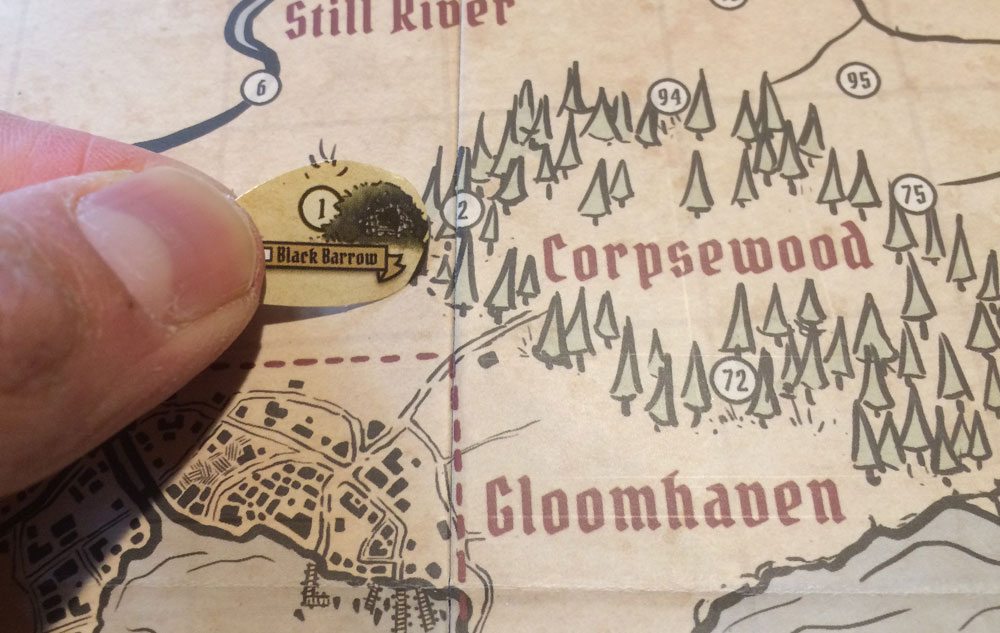
In the case of Gloomhaven, you start with a nearly-blank map of the world (including the town of Gloomhaven), and as you play, you will discover new quests, adding new locations to the map in the form of stickers. Your character will also level up as you play, unlocking new abilities either by getting access to new cards or by placing stickers on your existing cards. And your party will experience various events, making decisions about how to respond to particular situations: in some cases, once you make your choice and take the results, the card is permanently removed from the game. Sometimes, decisions you make will affect which scenarios are available for your party. Finally, as you play, your characters will retire, and new characters will be unlocked to continue the game.
There are some common complaints that apply to all legacy-style games: it’s hard to sell it used if you decide it’s not really for you, if you’ve already started marking on things and putting stickers on the board and tearing up cards. Nobody wants a used copy of Gloomhaven. (Note: if you wind up with a copy of Gloomhaven and you’re not sure it’ll work for your gaming group, I strongly recommend trying a Random Dungeon first—try out the game’s mechanics and see if they like those before you dig into the campaign materials, because then you could still give it away or sell it at that point.) This one is true, so if you’re in the habit of buying games, playing them a bit, and then selling them, Gloomhaven‘s resale value is not going to be nearly as high.
The other complaint is about the value: is it worth paying for a game that I can play a limited number of times before it’s “done”? Here’s my take: many hobby gamers I know (particularly Kickstarter backers) buy games so often that it’s probably rare that they’ll get 15–20 plays of any particular game before it gets replaced by the next new hotness. But legacy-style games motivate players to get the game out again and again, so they can unlock its secrets, meaning that you may get more plays per dollar than you did for your non-legacy game. In the case of Gloomhaven, if you finish the campaign I guarantee your dollar-per-play will be fairly low—plus, even after you’re done, you can continue playing it as a skirmish game with one-off Random Dungeons.
[Update] I just found out about a removable sticker set made by SinisterFish Games—they’re officially licensed, made from vinyl, and can be peeled back off the map and cards after use, plus there are stickers for the sealed envelopes so you can re-seal them. So if you got a set of these before you started, and you didn’t actually tear up cards but just stashed them somewhere, then I suppose you could play Gloomhaven once, and then remove all the stickers, and still be able to play the whole thing over or sell it afterward—you’d just have to get replacement character and party sheets.
Because of the nature of the game, there is an overarching storyline, and I won’t give away too many specifics. While I will include images of the game and its components, most of the specifics will be from the first scenario, and I will not show the contents of sealed envelopes (though, of course, I do have to show you at least the starting characters). If you want to avoid any hints of what is to come, I’d advise you not to look too carefully at the photos of all the components, but you probably won’t be able to tell too much at any rate.
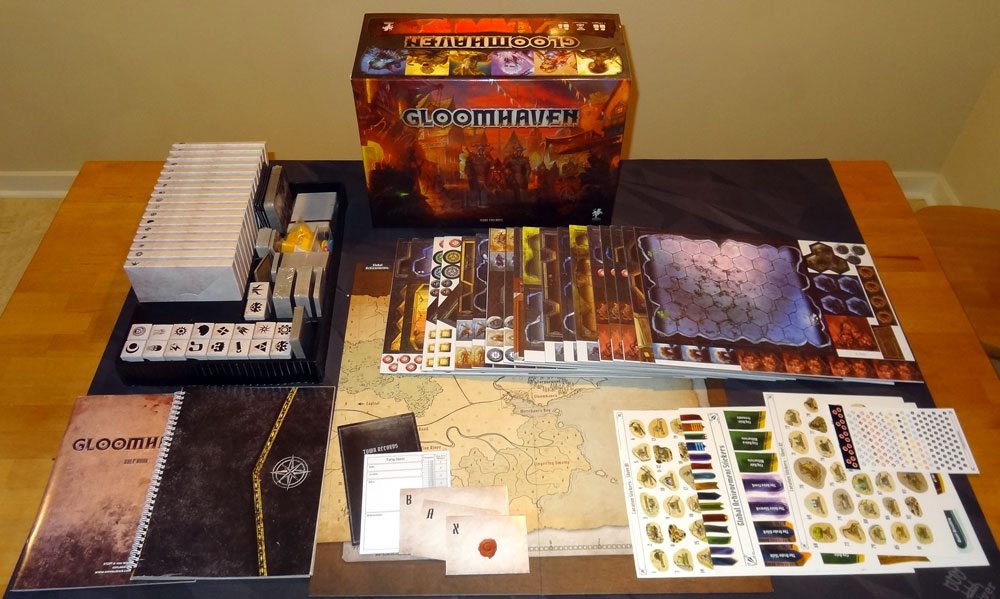
Components
What you need to know, first off, is that Gloomhaven is a huge box, particularly because it’s a really tall box. There’s a divider tray at the bottom that holds the cards, character miniatures, and each character’s envelope (seen at the top left of the photo) but everything else—including those 18 sheets of cardboard tokens and map tiles—doesn’t have any sort of organizational system. Sure, the Kickstarter page says “a custom insert to keep all of this organized,” but that’s just for a portion of the components. I don’t know if the second edition will actually have something better than this—if so, I’m not sure how it will all fit in the box before all the cardboard has been punched out.

Trust me: you do want to find some way to organize things, or else you’re going to be looking through thirty small baggies for the “Living Bones” monsters while the rest of your group gets impatient. Meeple Realty makes laser-cut wooden trays that look nice, but I imagine that box is really heavy. I went with four Chessex counter trays which hold just about all of the monsters and little tokens, and then I had to use another separate box for some of the larger obstacle tokens. The main problem, though, is that I can’t actually get all the trays back into the game box.
Okay, with that out of the way, here’s the lengthy components list:
- Rule book
- Scenario book
- Town Records book
- Map Board
- Party notepad
- 30 double-sided map tiles
- 155 double-sided overlay tiles
- 18 Character miniatures (in tuckboxes)
- 17 Character boards
- 17 Character notepads
- 504 Character Ability cards
- 85 Character tokens
- 457 Attack Modifier cards
- 236 Monster standees
- 232 Monster Ability cards
- 24 plastic stands (yellow and white)
- 47 Monster Stat sheets
- 6 Monster Stat sleeves
- 150 Event cards (69 Road Events, 81 City Events)
- 253 Item cards (228 Standard, 25 Random)
- 6 Element discs (wooden)
- Element Infusion board
- Round Tracker token
- 24 Battle Goal cards
- 24 Personal Quest cards
- 9 Random Scenario cards
- 40 Random Dungeon cards (20 Dungeon, 20 Monster)
- 4 Player Reference cards
- 32 Summon tokens (16 Summons, 16 Trackers)
- 60 Status tokens (Bless, Curse, Disarm, Immobilize, Wound, Muddle, Poison, Invisibility, Stun, Strengthen)
- 50 Money tokens (10 5-value, 40 1-value)
- 48 Damage tokens (6 10-value, 12 5-value, 30 1-value)
- 10 XP tokens
- 10 wood trackers (5 health, 5 XP)
- 12 Number tokens
- 4 Sticker sheets
- 4 Sealed Envelopes
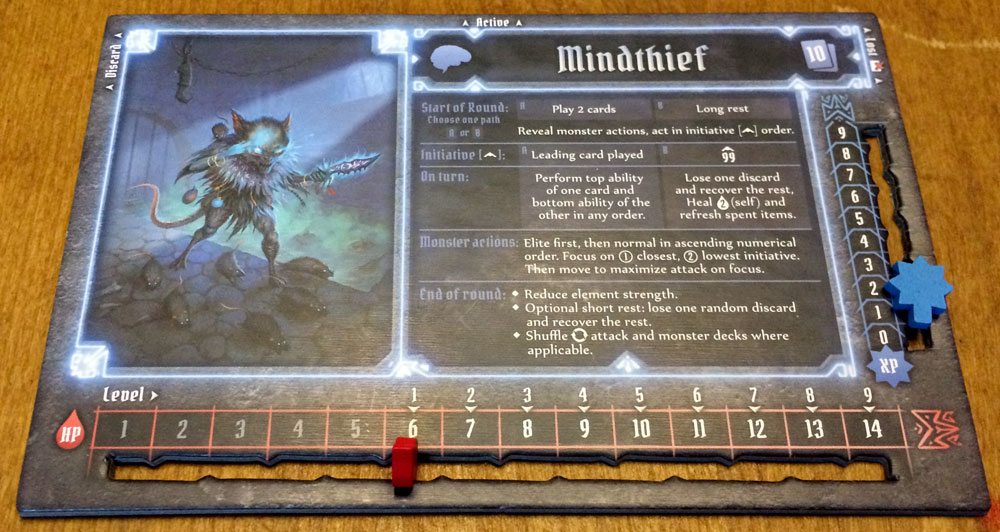
The character components come in a small tuckbox—it includes a character board, a notepad, roughly 30 Character Ability cards, some tiny tokens, and a set of small Attack Modifier cards that will come into play as you upgrade your character. At the start of the campaign, you have access to 6 of the characters—the rest you will have to unlock as you play.
The character boards have little grooves for tracking health and XP, which you’re supposed to do with the tiny wooden trackers. However, we found that the tolerances for the tracker pegs aren’t great—some of them are loose in some spots and fall over. The current Kickstarter campaign includes upgraded trackers (available as an add-on for those who own the game already) that have dials instead—I would highly recommend looking into those.
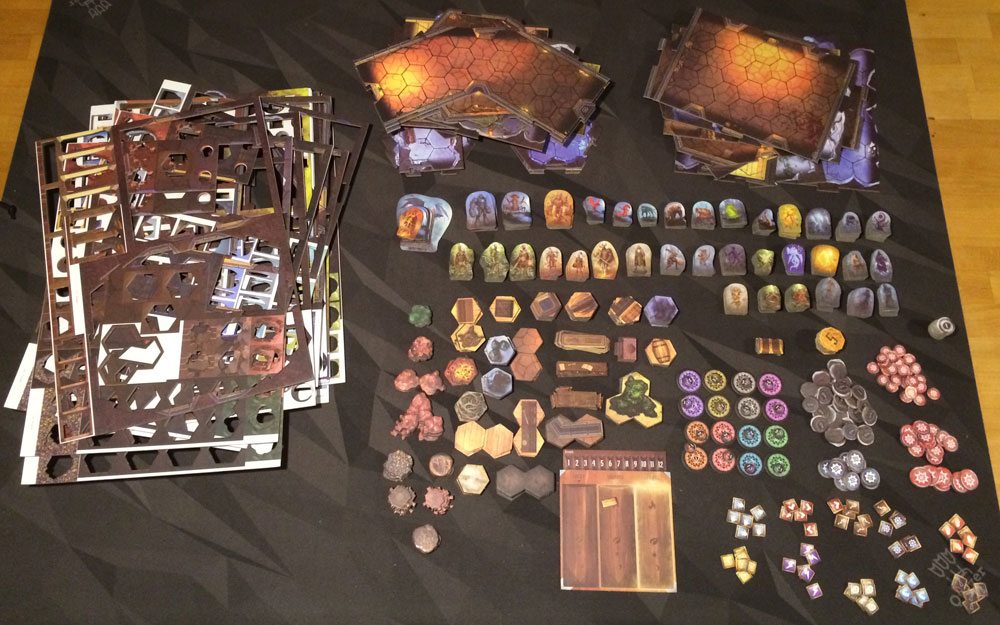
There is a pile of map tiles, each labeled with a letter of the alphabet (corresponding to the map tile shape), as well as a number and either “a” or “b” for the two sides. Keeping those organized makes it much easier to find the right map tiles for setting up scenarios.
The overlay tiles include traps, obstacles, treasure chests, and other things that may be placed on the map as you play. They’re double-sided, so you get a lot of options in those 155 tokens. However, there are tokens that don’t share the same fronts and backs, so that makes organizing these tokens a little tricky, because if you group the small bushes then you’ve split up the lava pools, or something like that.
There are plenty of other little tokens—status tokens, damage counters, and so on—and some of them are fairly tiny, but they need to be in order to fit where they’re used.
The Monster standees come in a couple different sizes, with 4 to 10 of most of the monsters, and a couple of unique boss monsters. The monsters are numbered (with very tiny numbers), so that when you’re playing you can differentiate between monsters of the same type, both for initiative order and for tracking damage and status effects. I do wish the numbers were a little larger, but they work all right. There’s a shared set of plastic stands—yellow for elite monsters, white for regular monsters—so as you play you’ll have to pull monsters out of stands and put new ones in.
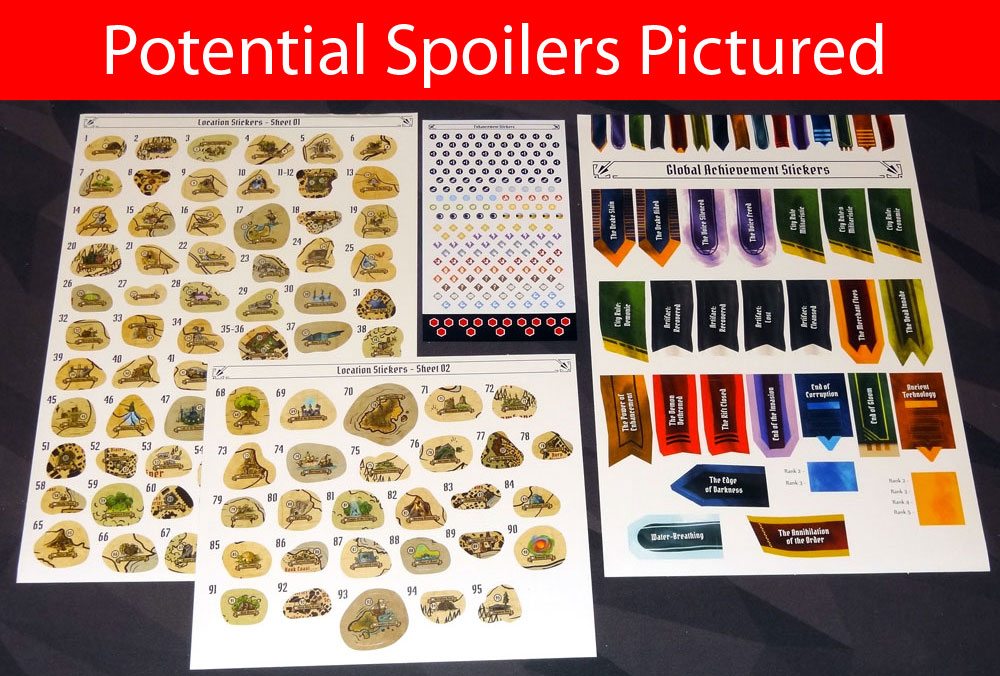
The four sticker sheets include a lot of location stickers that correspond to scenarios—these are placed onto the map board as scenarios become available to your party. Each one has a number, a name, and a checkbox (for when you’ve completed it). The map board has all of the numbers on it already, but without the location illustration, so as you add stickers, you get a neat effect of filling in the map with various landmarks. I even noticed that stickers that cross the cut in the map board are pre-cut, so that you can still fold up the map board and not ruin the stickers.

There are also Global Achievement stickers, which look like pennants. These go across the top of the map board and indicate the state of the world. Some stickers have the same shape, which means that you can only have one of those achievements at any given time, and some achievements even have multiple levels so you’ll add bands to them.
The last sticker sheet, the smallest, is for upgrades to Character Ability cards. As you upgrade your character, you’ll be able to purchase these and add them to your cards, adding extra damage or status effects to an attack, or increasing area attacks.
At the bottom of the map, there’s a Prosperity track showing the prosperity level of Gloomhaven as you play. As you increase the prosperity, more things will become available to you—for instance, more items will be available to purchase. The Prosperity level also affects the starting level of new characters.

Overall, the components in the game are pretty nice—it’s just an impressive collection no matter how you look at it. The miniatures for the heroes (at least the ones I’ve seen so far) are pretty cool, with a wide range of body sizes and types, from the tiny rat-like Vermling to the huge Inox brute. The game does use mini-cards (for the Attack Modifiers and Monster Abilities) so if you dislike those, that may bother you. My only overall complaint is that there is a lot of very small text on the cards and components, so get out your reading glasses if you have them.
How to Play
There’s a hefty 50-page rulebook (available here as a PDF), or you can watch a half-hour rules video if you prefer, but I’ll try to give a short(ish) overview.
Gloomhaven is a cooperative game—your party will have a particular goal for each scenario you play, but typically it will involve kicking down doors and fighting whatever’s behind them. Ultimately, of course, you will probably want to play through the scenario book and follow the storyline where it leads you, but there are also Random Dungeon cards provided so that you can create a randomized 3-room dungeon if you just want to play the game without having any sort of legacy effects on the rest of the campaign.
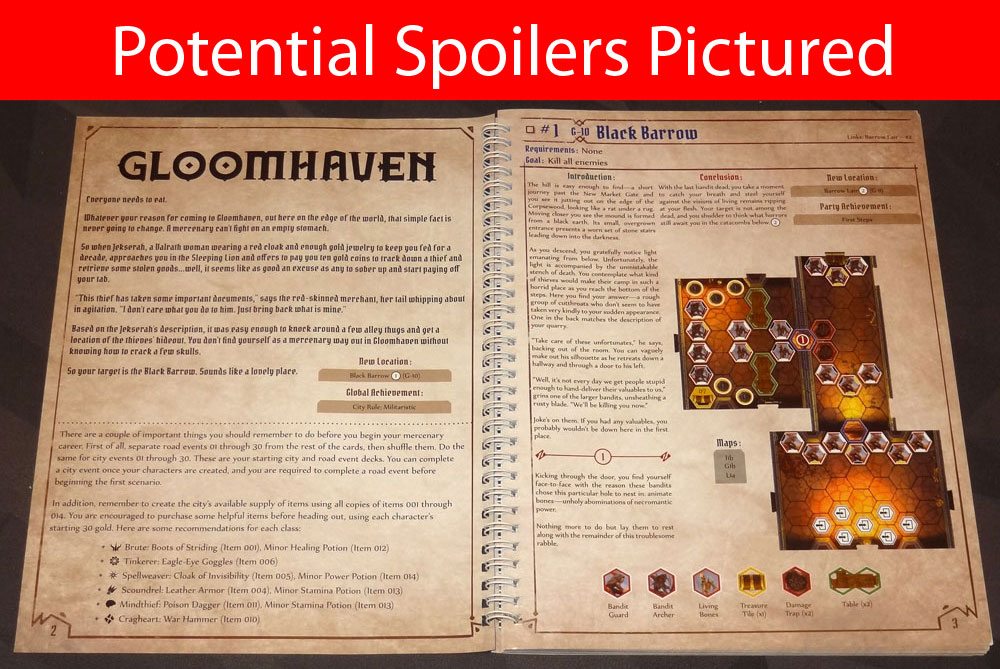
If you do play the scenario, you turn to the particular scenario, which will show the map setup and the various monsters and overlay tiles you’ll need. There’s an introduction telling you the story of what is happening, and there’s often another section to read when a particular door is opened, as well as a conclusion to be read if you manage to succeed at the scenario. Typically, you only place the monsters in the starting room, and you only fill the other rooms as you open doors. Unfortunately, there’s not a great way to avoid seeing the other rooms on the page, but if there were multiple pages per scenario I guess we’d be looking at a 300-page scenario book.
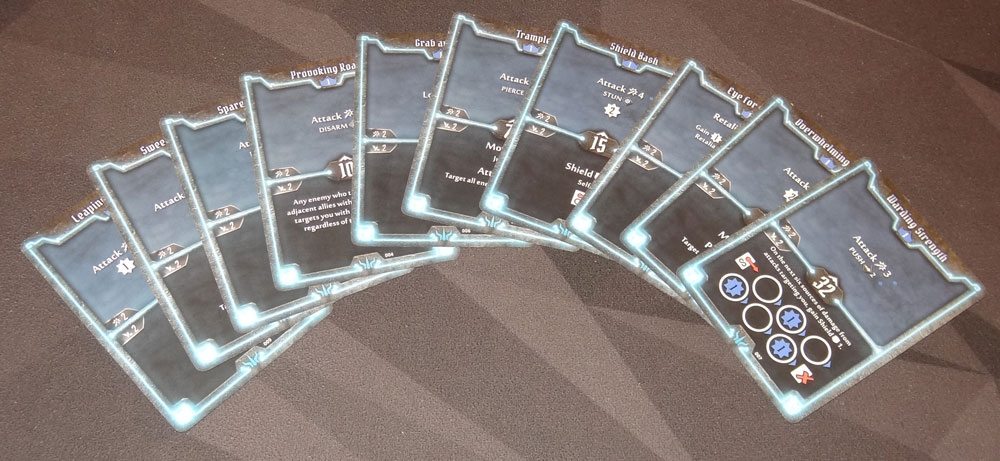
You’ll start with your character board at full health (according to your current level), and a full hand of your ability cards, plus an Attack Modifier deck. As you level up your character, your maximum health increases, but your hand size does not. You’ll get access to more powerful cards, but each time you begin you will have to choose which cards to bring to the scenario. At the very beginning of the game, you have access to the level 1 cards (indicated at the top of the card) as well as three level X cards, which can be swapped in for any of these.
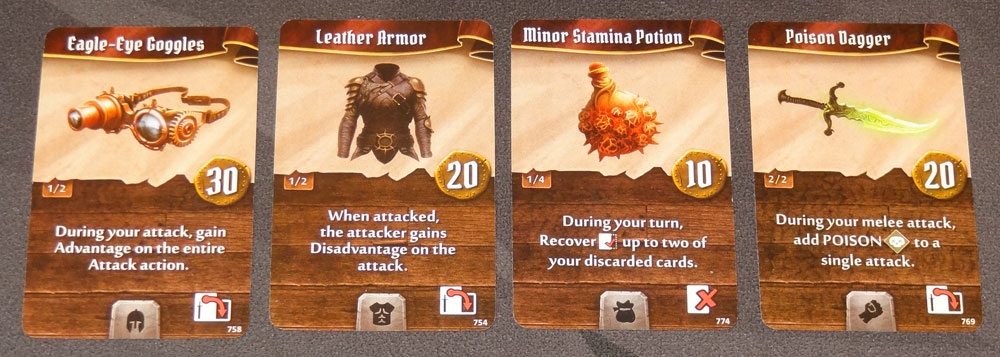
You also get some gold at the very beginning of the campaign, which you can spend on equipment (and the rulebook has suggested equipment for each class). Equipment comes in various types: head, body, legs, hands, and small items. While your character can own any number of items, you can only bring so much with you per scenario. The number of small items you can carry increases as you level up. Some items are spent but can be refreshed during a scenario, and some can only be refreshed between scenarios.

Each round, every player selects two cards from their hand to play. The large number in the center of the card is your initiative, and you choose one of the two cards as your initiative number. Each monster type also has a deck of small monster ability cards, with initiative numbers in the top corner. Once all players have chosen their cards, they’re revealed simultaneously, and then you draw an ability card for each monster type present. The players and monsters will then take turns in initiative order, from lowest number to highest.

When it’s your turn, you play the two cards you have chosen in whatever order you prefer, but you must use the top half of one card and the bottom half of the other card. You can always do a default action of Attack 2 for the top half and Move 2 for the bottom half if you choose. Every card has different effects: some cards have ongoing effects that may last for a round or indefinitely; you might move and then stun an enemy; you may perform a powerful attack. Some cards also give you XP if you use the effect. The most powerful abilities also have an “X” symbol (as seen on the Overwhelming Assault card above)—if you use the card for that particular effect, you put it into your lost cards pile. Otherwise, after playing your card, you put your cards into your own discard pile.
So how do you get cards back? By resting. You can either take a short rest at the end of a round, or you can take a long rest as your entire action (with initiative 99) for a round. For a short rest, you shuffle your discard pile and randomly put one of them into your lost cards pile, and then put the rest in your hand. If you choose, you may lose 1 health to choose a different card to lose instead. For a long rest, you pick up your discard pile and choose which card is lost, and you also heal 2 hit points and refresh your spent item cards. Note that you can only rest if there are at least two cards in your discard pile.
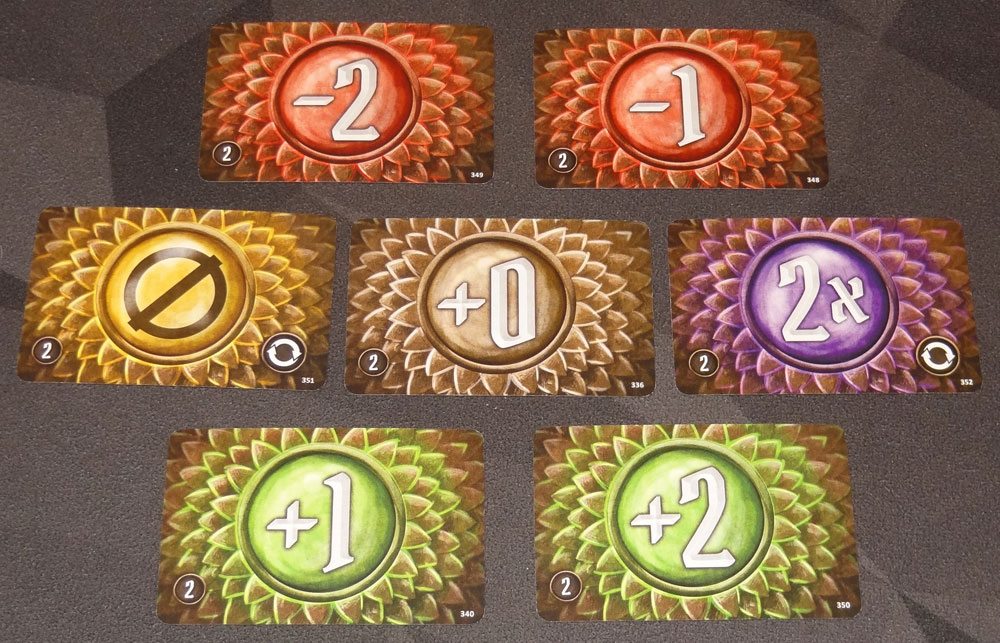
Whenever you attack, you have a base damage, and then you flip a card in your own Attack Modifier deck. These generally range from -2 to +2, but there’s also a null and a double. That determines how much damage you do, which is then compared to the enemy’s shield value—any overage is taken as damage. Do enough damage, and the monster dies, leaving coins behind. (You’ll have to land on the coins or use the “Loot” ability to pick them up.) You may also have additional status effects, which can immobilize an enemy for a turn, or poison them so they take extra damage, and so on. As you earn perks, you’ll have the opportunity to customize your Attack Modifier deck as well, removing some of the weaker cards or adding in cards that have additional status effects.
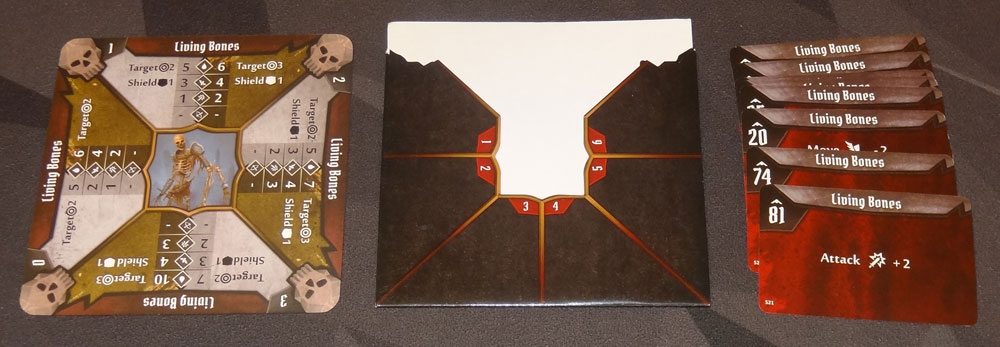
Of course, this would be a cakewalk if the monsters just stood around waiting for you to kill them. So here’s how the monsters work. Each monster type has a stats card with levels from 0 to 7. The card fits into a sleeve so that only one level is visible. The left side shows the stats for the regular monster, and the right side shows the stats for the elite monster. Each monster has health, speed, attack strength, and attack range (no range means it’s melee attack only). In addition, there may be other effects like Shield (reduces damage) or Target (hits more than one opponent per attack). The sleeve itself is divided up into numbered sections, so you can place damage and status tokens, corresponding to the numbered monster standees on the board. (Some sleeves have up to 10 sections.)

Each round, when it’s the monster’s initiative turn, every monster of that type will activate, starting with the elites in numerical order and then the regular monsters in numerical order. The action they take depends on the card that was drawn—they might move and attack, or just attack, or shield themselves, and so on. When monsters attack you, they also have a deck of Attack Modifiers that will affect their attacks.
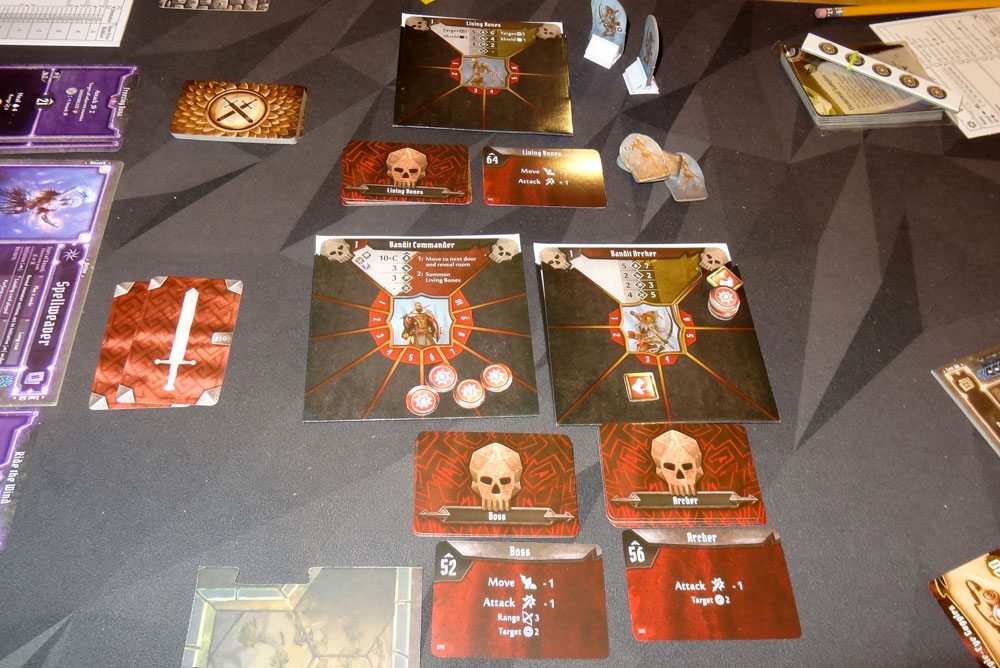
When you take damage, you move your hit point marker on your board. Or, you may also lose cards—either one from your hand or two from your discard pile—to prevent all the damage from one attack. If you ever run out of hit points, you’re exhausted and are basically out for the rest of the scenario. You’re also exhausted if, at the beginning of a round, you’re unable to play two cards and you can’t rest because there aren’t enough cards left in your discard pile.
If you accomplish the scenario’s objective (in the case of the Random Dungeon, kill all the monsters in all three rooms), then you win—everyone will gain experience points and the gold they acquired. For the campaign, you usually will also find out about an additional scenario to add to the map. If all the characters are exhausted, then the scenario is lost.
There are, of course, a lot of other details that come into play: you can tweak the difficulty of the scenarios; there are elements that can augment certain abilities when they’re in effect; there are specific rules about line of sight and movement; and so on. In campaign mode, each character also has a long-term personal quest—when you accomplish it, you actually retire your character from the game and start a new one—and short-term battle quests that can earn you perks if you accomplish them during a scenario. There are also City Events and Road Events, choose-a-path cards that will take place when you’re in the town of Gloomhaven or traveling to scenarios from Gloomhaven. Your party has a reputation and its own set of achievements—some results of decisions will depend on your party’s reputation, which is itself affected by the choices you make.
The Verdict
I’ll start with this: despite the overwhelming success of the Kickstarter campaign, Gloomhaven isn’t for everyone. It’s a pricey game that will take perhaps hundreds of hours to play to completion: do you have a dedicated gaming group that can commit to playing a single game regularly for that long? Not everyone likes the idea of legacy-style games, in which cards get torn up, boards get written on, things get permanently altered during the course of play. Gloomhaven is a hybrid of a board game and a role-playing game, so it really benefits from players who really want to invest themselves in the story and the world of the game.
Here’s who it’s not for: if you’re not interested in a long campaign and you just want a monster-fighting skirmish game where each session is a separate, closed loop, then Gloomhaven is not the game for you. (You can play it that way, but then you’re paying a lot more for the content that you’re not using.) It’s not great for those who have analysis paralysis unless you plan to spend double the total length to get through the game. It’s not even really for those people who love buying games for the cool minis, because there are only minis for the hero characters and not the monsters. (If you are just in it for the minis, though, there is an add-on level in this campaign for a set of miniatures.) And, of course, it’s not for those who like games that you can open up and learn in 10 minutes—this one will take a good deal of reading before you can even get started.
That said, I’m really digging it. It’s not for everyone, but it is definitely for me. I’m nowhere near completion yet, because I’ve been trying out the game with a couple different groups, trying to figure out who’s going to be a committed party that I can carry through the campaign, but I’ve seen enough to know that I really enjoy it—and if I weren’t constantly playing new games for review (and running my weekly Pathfinder Adventure Card Game sessions), I could totally see myself just playing Gloomhaven every possible opportunity until I finished. (Hey, game publishers and designers: can you put everything on hold for about 2 years? Thanks!)
A quick note about the age recommendations and playing time: I’ve played mostly with my adult gamer friends, but my 10-year-old also joined me for one of the plays, and she really enjoyed it. The game does require some tough decisions, but I think kids who have some experience with games (particularly role-playing games) will probably be able to handle it, as long as you’ve got somebody who knows the rules well to direct the game. I’ve played with new parties 3 times, and I’ve found that the first time with a new party is always the longest—up to 4 or 5 hours for a single scenario—but that it cuts down significantly the second time, because then you’re no longer learning both the game mechanics and your character’s abilities and trying to figure out the best move for the round.
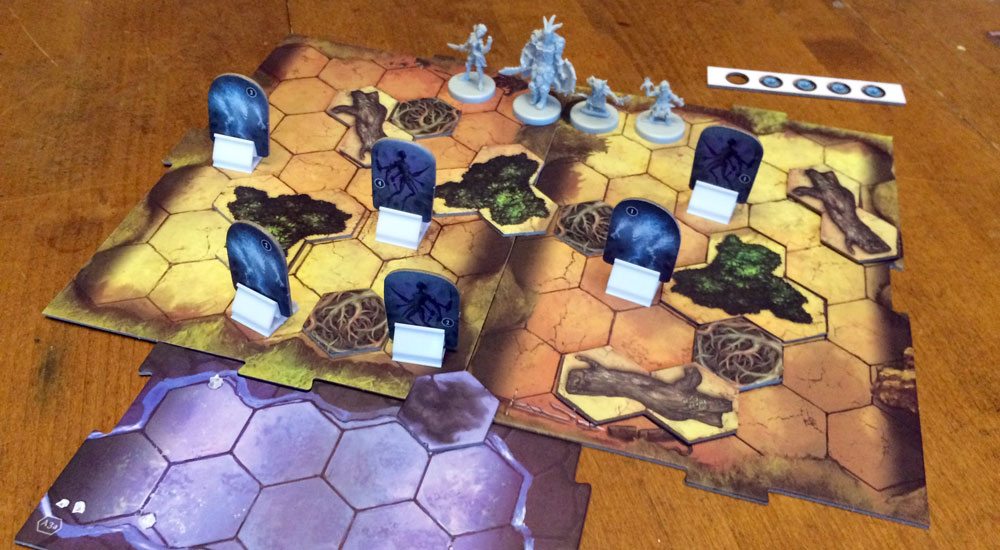
Here’s what I love about Gloomhaven:
- Game Mechanics: I like the structure of the game, the way your cards determine your turn order, the way you use the top half of one card and the bottom of another (and the flexibility of choosing which half of each card to use after you’ve seen what your teammates and the monsters are doing). I like that the monsters are “programmed” in such a way that they’re not totally predictable, the way automated monsters are in most DM-less games.
- The World: I’ve only scratched the surface so far, but I like the world that designer Isaac Childres has built for the game. Okay, yes, it’s another fantasy world and you go around killing monsters, but I like that the various characters aren’t your typical fantasy races and classes (at least what I’ve seen so far).
- Character Abilities: This goes along with the world-building, but I like the way that the characters have such different abilities, and that the game changes depending on who’s in your party. Even the results of event cards can be different depending on who’s in your party at the time, which is thematically appropriate: you’re not going to get the same results if you have a huge brute with you instead of a charming scoundrel.
- Tough Decisions: One of my big requirements for a good game is that you get to make meaningful choices, and it feels like every decision in Gloomhaven is important. I’m not just talking about when you upgrade your character and you’re making choices that will affect the rest of the campaign, though that’s certainly true. I mean, I only have so many cards in my hand, and if I run out, I’m a sitting duck for a round, but every time I rest you lose a card permanently, so do I take a short rest now so I can get cards back or do I wait and take a long rest so I can also get my health but then I’m sitting there for an entire round and my team needs me and… yeah, this is why it can lead to analysis paralysis. But if you win, you feel like you earned it. Even the choice of which card to lose when you rest can be a painful one.
- Multiple Parties: While I think the best way to play Gloomhaven is to have one consistent group that plays through the whole thing, it’s interesting to me that you can have multiple parties co-existing in the world. There are some scenarios that are in the primary storyline, but there are also side quests that you can pursue, and depending on your gaming group, you could have some parties pursue side quests while one party follows the main storyline, or you can even have different teams take on the main storyline if you like. The only issue, of course, is that players who aren’t present will miss parts of the story… but that’s also thematically okay. Not everyone knows what’s going on in the entire world all the time.
I’m seriously impressed by the sheer amount of content in Gloomhaven, particularly considering its price. Yes, it’s $100, which is not a cheap game, but when I compare it to other games I’ve purchased or reviewed, it still seems like a whole lot of game for the money. For instance, I backed Shadows of Brimstone, another cooperative dungeon-crawl-style game that has some campaign elements to it, and I paid $150 for the two base sets (which now retail for $200 or so). That one has a ton of plastic miniatures, so that’s a lot of the expense there, but there are a dozen scenarios in each set. Gloomhaven has 95 scenarios in the book (I think technically you don’t play all of them, because sometimes a decision you make will close off one path and open up another), plus there’s a set of solo campaigns so that you can play a character-driven campaign for each particular character. Or, compared to another legacy game, Pandemic: Legacy was originally $80 when it was released, and that was only 12 scenarios. So if you enjoy playing Gloomhaven, rest assured that you’re getting your money’s worth.
For the Kickstarter campaign, Childres has even been running a series of special scenarios, written just for this campaign. He releases a downloadable PDF of the scenario, and then posts a poll for any special decisions you’d have to make at the end of the scenario, creating a new scenario based on the poll results. It’s kind of a crazy pace to be creating scenarios, and I haven’t had time to follow them myself, but I’ve been reading the storyline at least, which has been fun.
Gloomhaven isn’t perfect. It’s a massive, impressive piece of work, but it does have some problems—in a game of this scope, it’s not surprising that there are a lot of situations that are confusing, and the Official FAQ is quite long. (Hopefully the updated rulebook will address a lot of those issues.) There are things that aren’t intuitive, and a lot of rules that are easily missed or misread when you first start playing.
However, for the right players, Gloomhaven is like stepping into an amazing world that’s ready for exploration. The feeling of discovery when you open up a treasure chest or turn a new page in the scenario book, when you make a decision for an Event card and then flip it over to see what the results are—it’s like the feeling you get when you read an engaging book or watch a movie for the first time, and it’s something that legacy-style games can give you session after session, not just the first time you open up the box.

As of this writing, there’s still about a week and a half left to go on the campaign. If any of the above sounds intriguing, I encourage you to visit the Gloomhaven Kickstarter page and take a closer look. Yes, there’s a whole lot of hyperbole on that page (and the pitch video is simply a huge series of gushing quotes), but at least some of it is warranted. I’m giving it the GeekDad Approved seal not because it’s great for everyone, but because for its target audience, it’s likely to become a favorite.
If you’ve gotten this far and you’re still with me, you just might be the target audience too. Check out the Gloomhaven Kickstarter page now!
Disclosure: I received a copy from the first printing for review purposes.

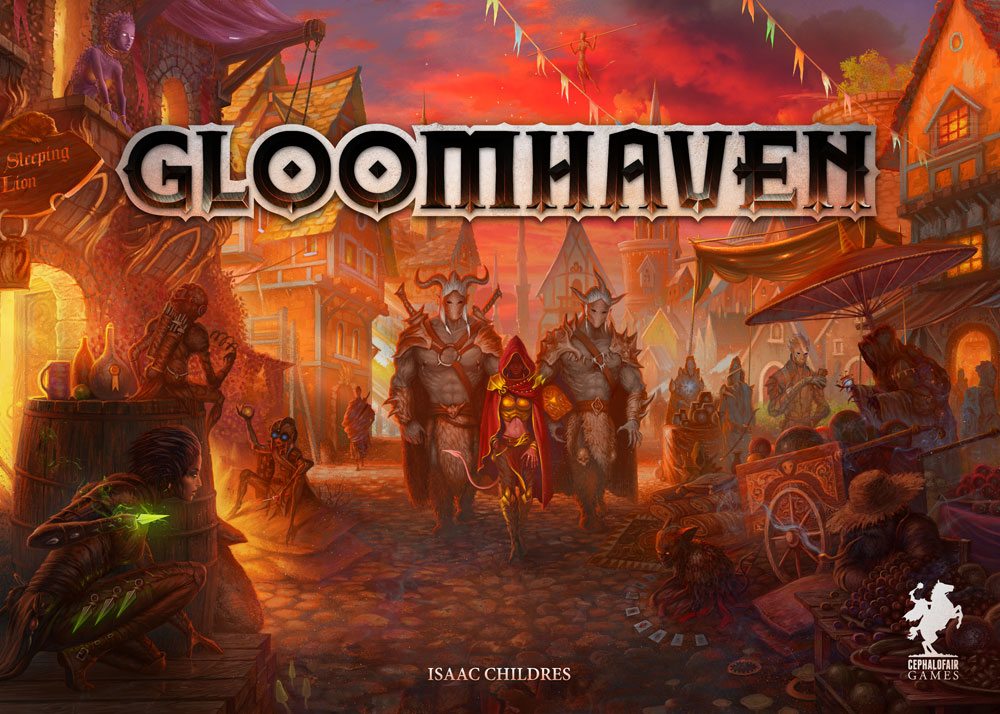
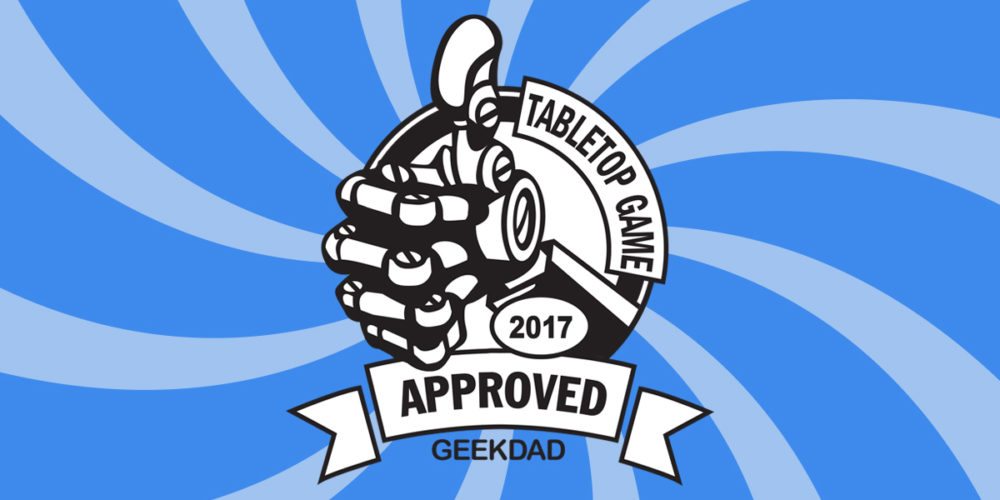


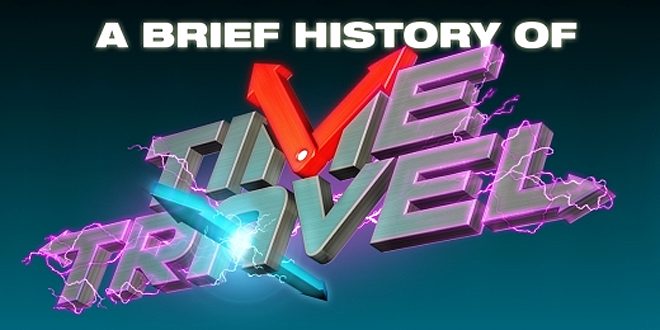
Recommended.